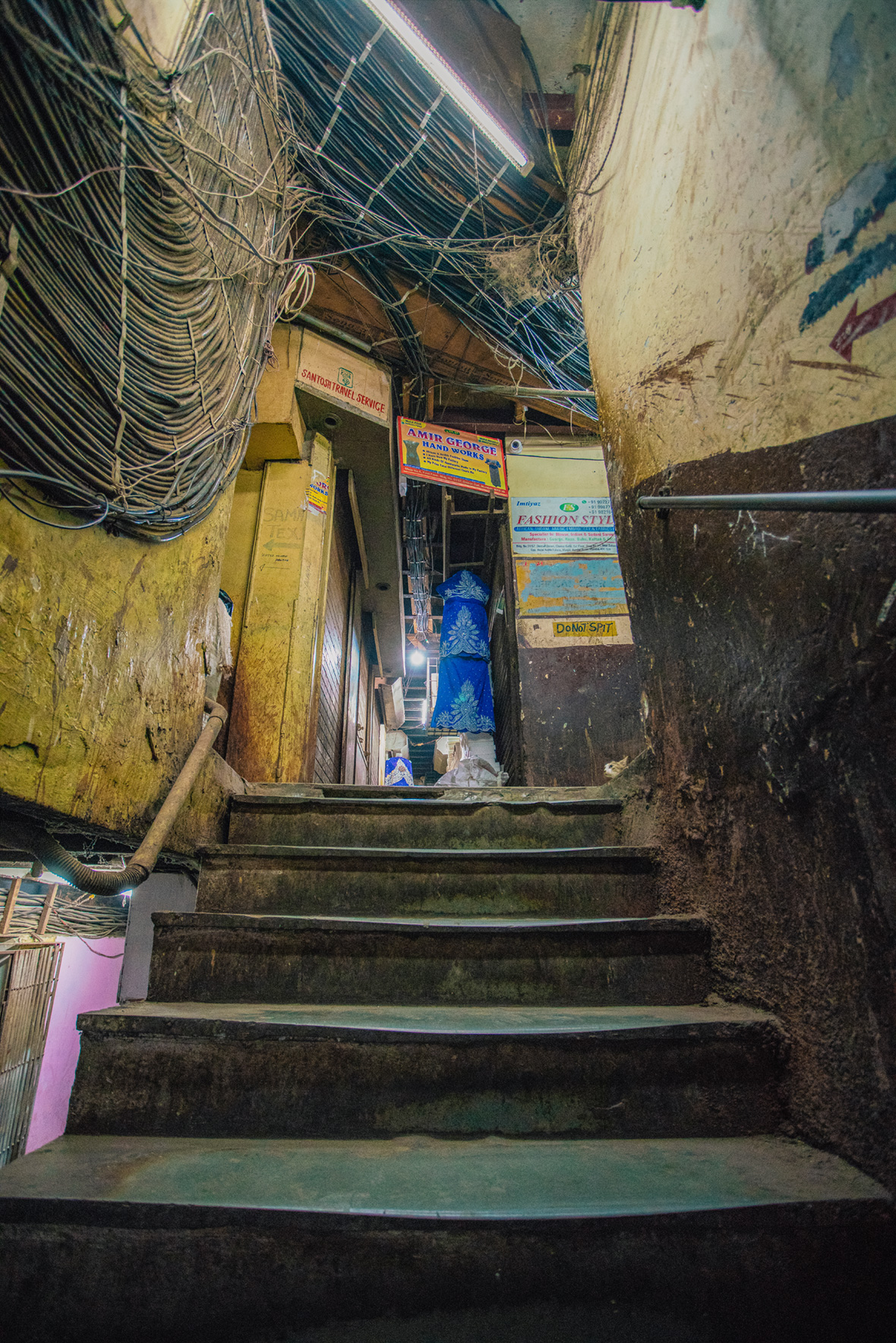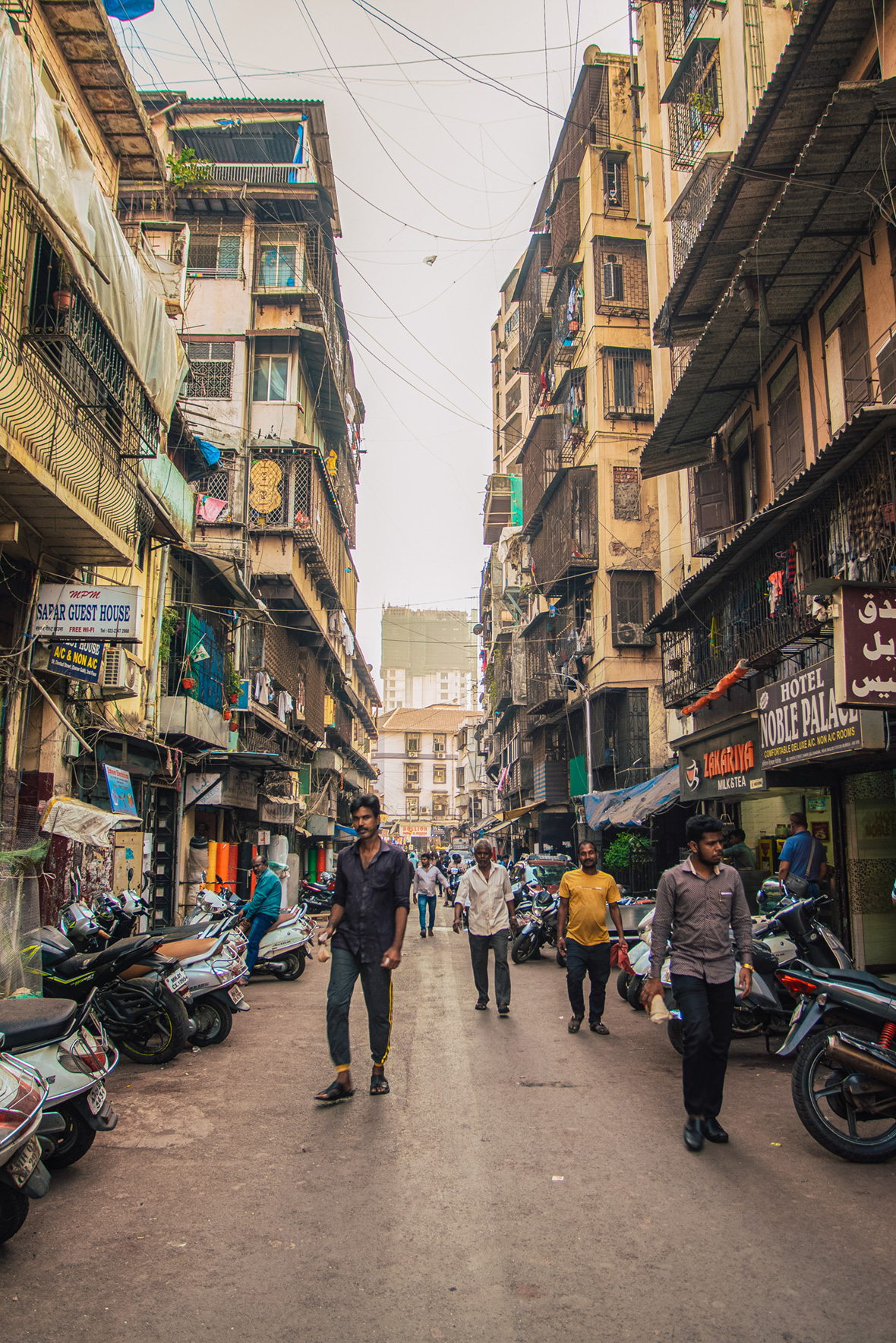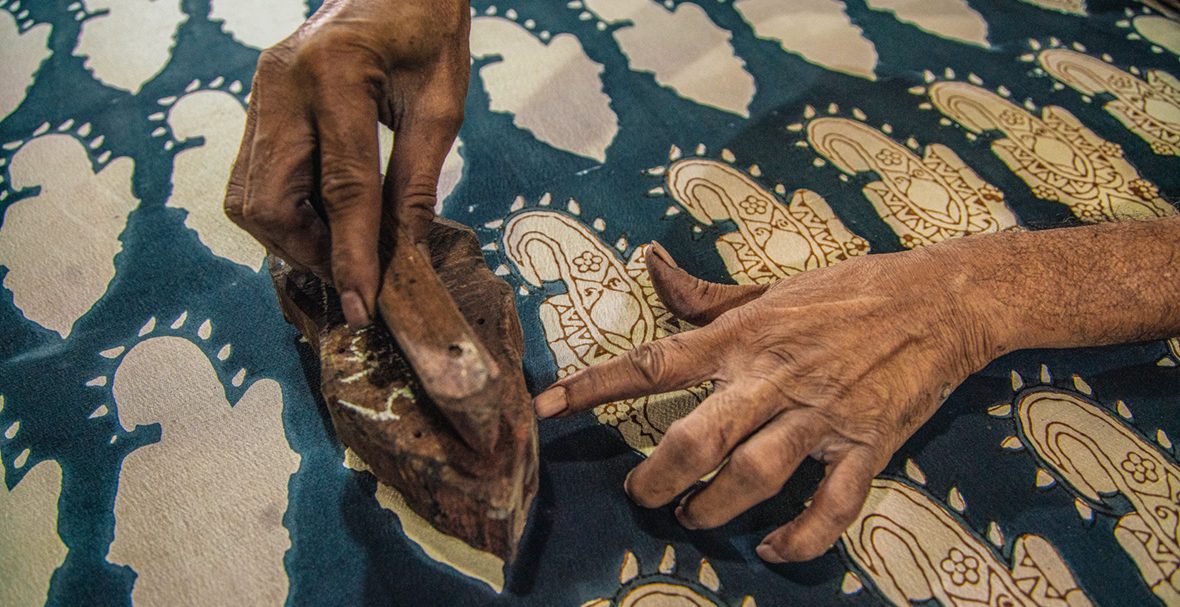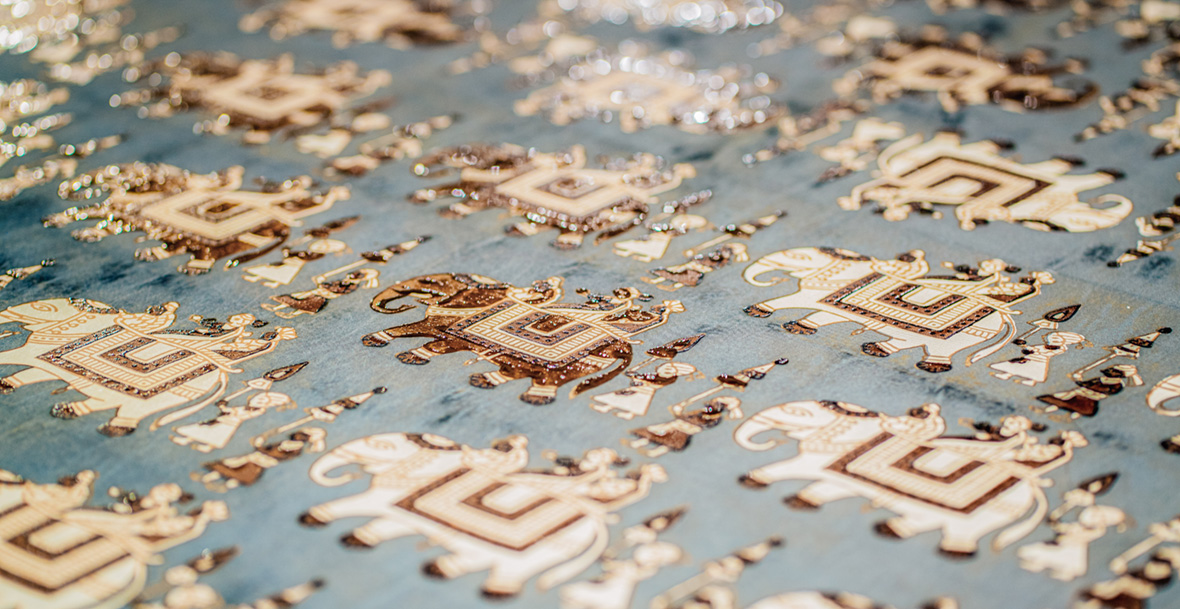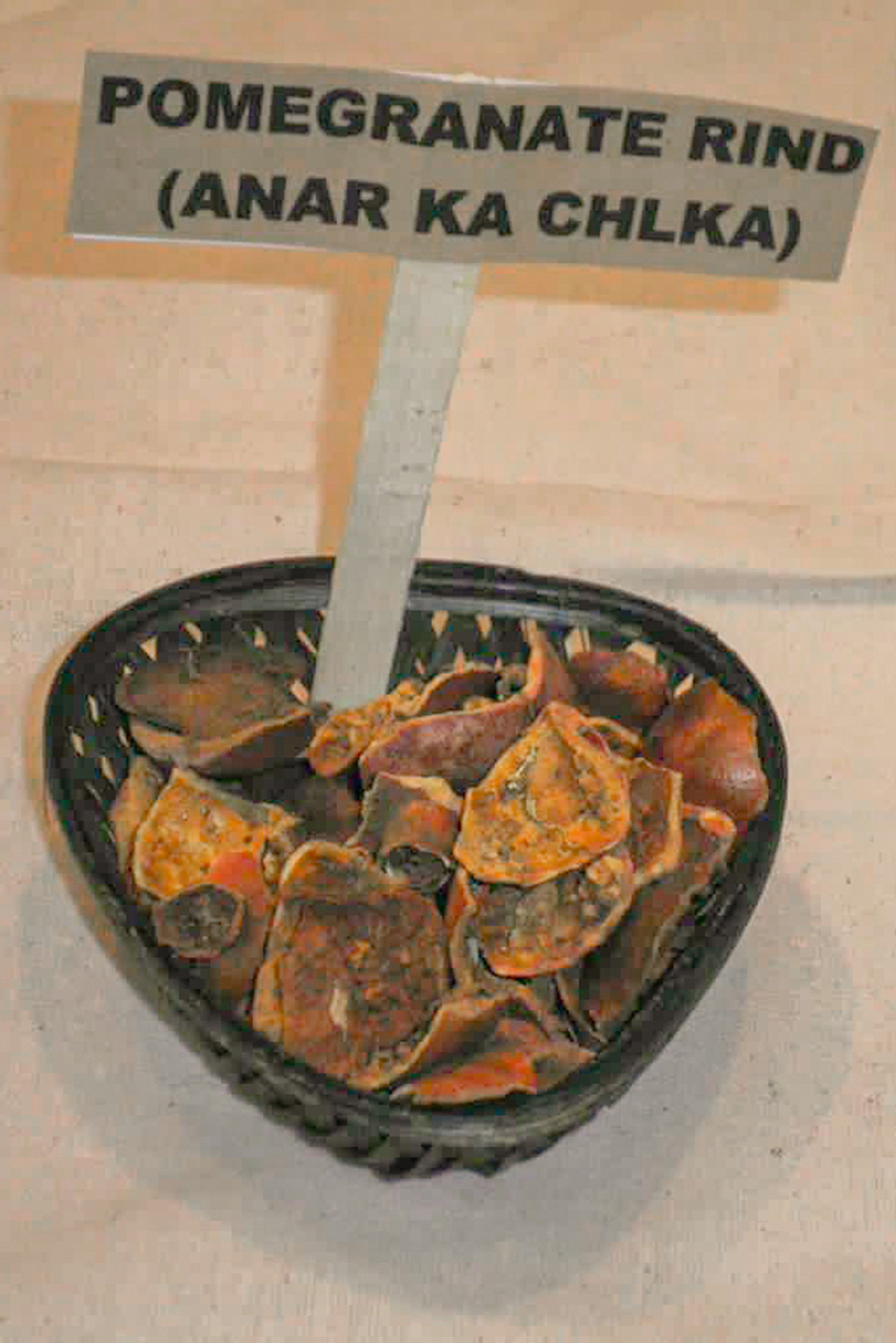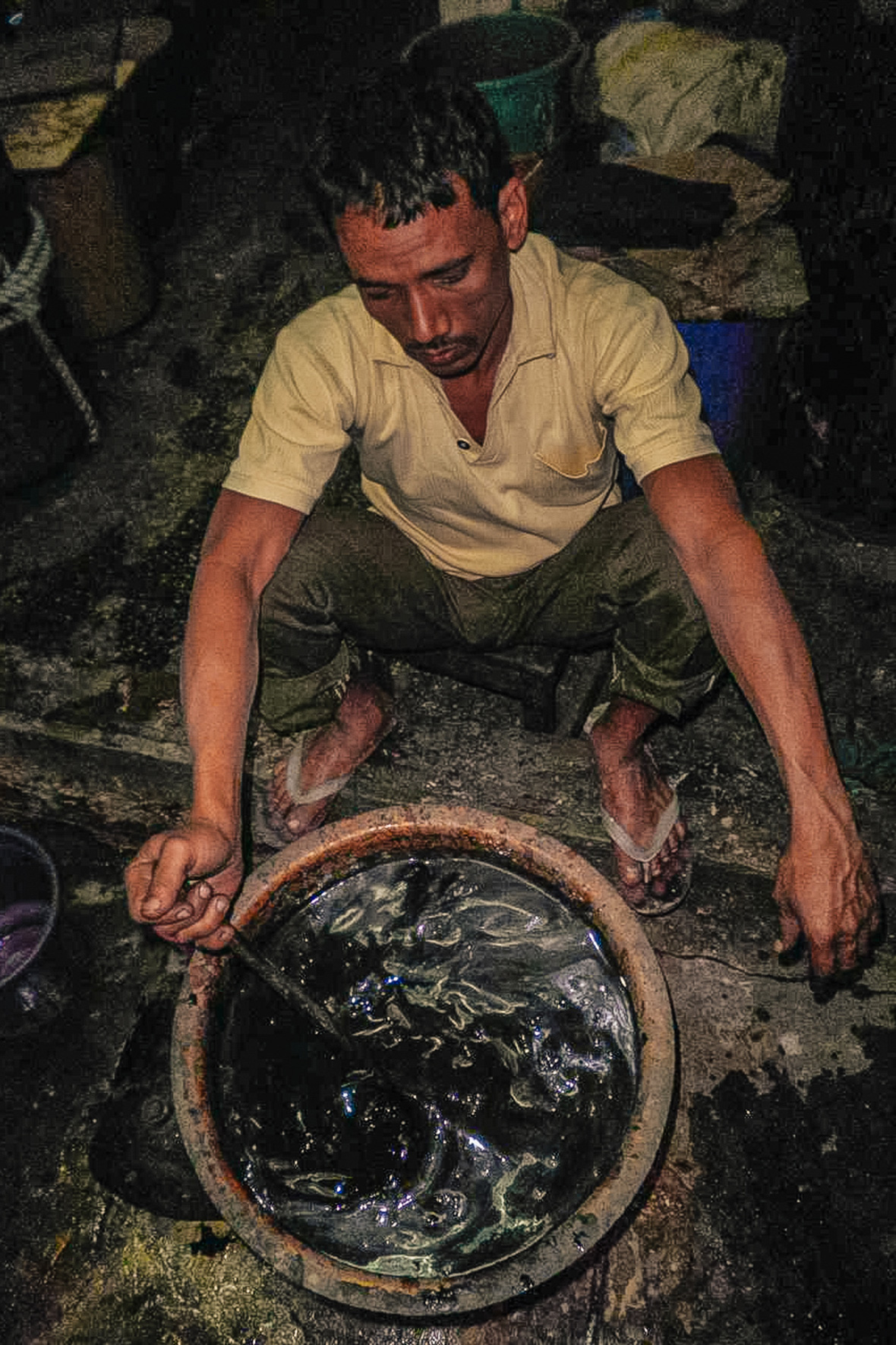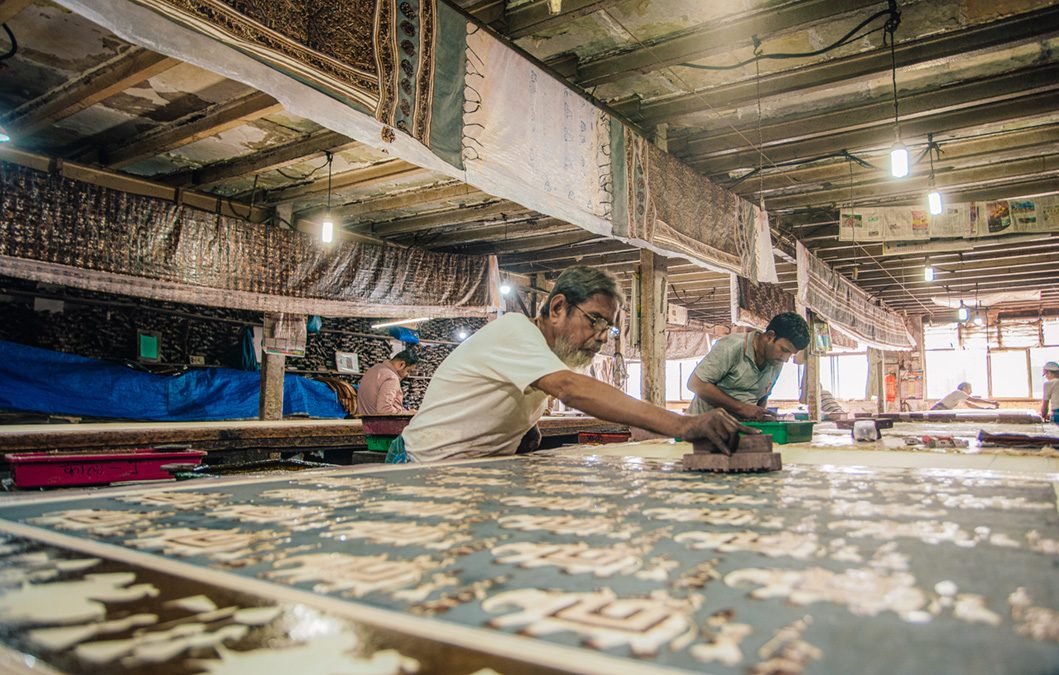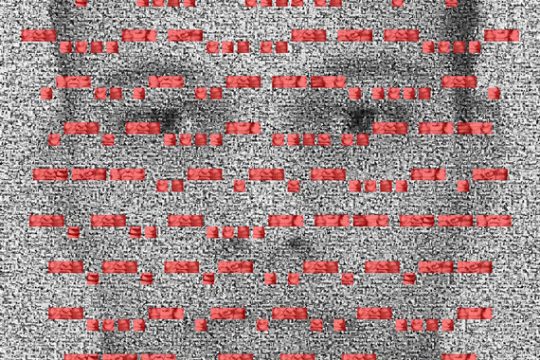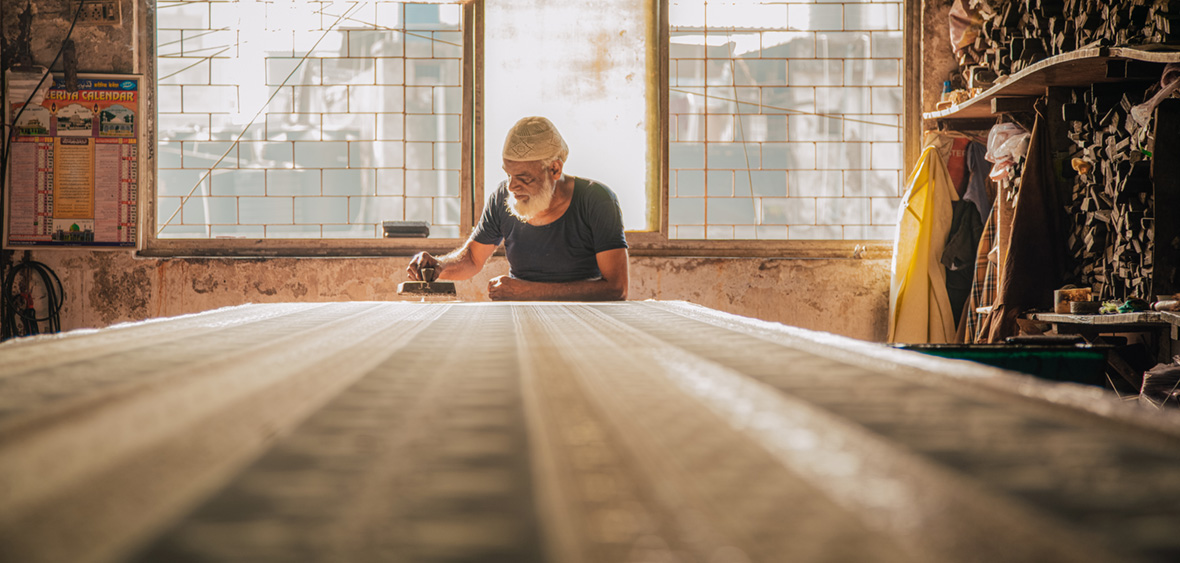
Kamanuddin doesn’t enjoy being observed as he works. Yet the bearded septuagenarian remains composed as he bends over a stretch of long white fabric, firmly holding a wooden block in his wrinkled, stained hands as he continues with what he does best—blockprinting. The indigo-colored motif he’s just stamped seems to almost glisten under the sunlight streaming in through the large windows behind him. Kamanuddin has spent over 40 years working as a professional blockprinter. He is one of the twelve kaarigars (meaning “artisan” in Hindi) at Mumbai blockprinting workshop Pracheen, the only one in the city that continues to use natural dyes.
Kamanuddin 平时喜欢一个人埋头创作。这位留着胡子的七旬老人正佝偻着身子,爬伏在一块长长的白色织布上。他那布满皱纹的双手侵泡在颜料里,牢牢地握住一块木刷板。这是他多年来最擅长做的一件事——木刻印刷。在他身后,明媚的阳光透过巨大的窗户投射进来,新鲜出炉的靛蓝色图案看起来闪闪发光。Kamanuddin 从事木刻印刷已经有 40 多年的时间,他是孟买木刻印刷作坊 Pracheen 的 12 位 “kaarigars”(印地语“工匠”的意思)之一。这里是当地唯一还在使用天然染料进行木刻印刷的作坊。
Occupying a space of 2200 sq feet, the workshop and store is tucked away on the fourth floor of a rundown building situated in the narrow bylanes of Damar Galli off of Mumbai’s Mohammad Ali Road. Yet the small unit embodies the artistic spirit of Ajrakh, a distinctive form of blockprinting found in Pakistan, Rajasthan, Gujarat, and India; Ajrakh prints echo the complex patterns of Islamic architecture, such as jali windows and trefoil arches. In recent years, these designs have even found their way into high fashion. Traditionally, Ajrakh has always used natural dyes that require effort and resources, rendering it expensive. To reduce costs, many have turned to chemical dyes to produce Ajrakh designs on the cheap.
藏匿于孟买 Mohammad Ali 路附近的 Damar Galli 小巷内,便可以找到这家名为 Pracheen 的作坊。整个作坊共占地 2200 平方英尺,位于一栋破旧建筑物的四层内。虽然总面积不大,但这间小小的作坊却传承着历史悠久的 Ajrakh 印花工艺。这种印花艺术源于巴基斯坦、拉贾斯坦邦、古吉拉特邦和印度等地,是一种独特的木刻印刷工艺。Ajrakh 在很多伊斯兰建筑的复杂图案中都有迹可循,例如 Jali 窗户和三叶形拱门。近年来,这些图案甚至被应用于高级时装设计当中。
传统 Ajrakh 以天然染料制成,而天然染料往往需要大量人力和资源来制作,十分昂贵。为了降低成本,许多人已经转向使用化学染料,制作出价格更低廉的 Ajrakh 印花。如今,你仍会在印度一些乡下地区,看到有一些使用天然染料的 Ajrakh 工匠。
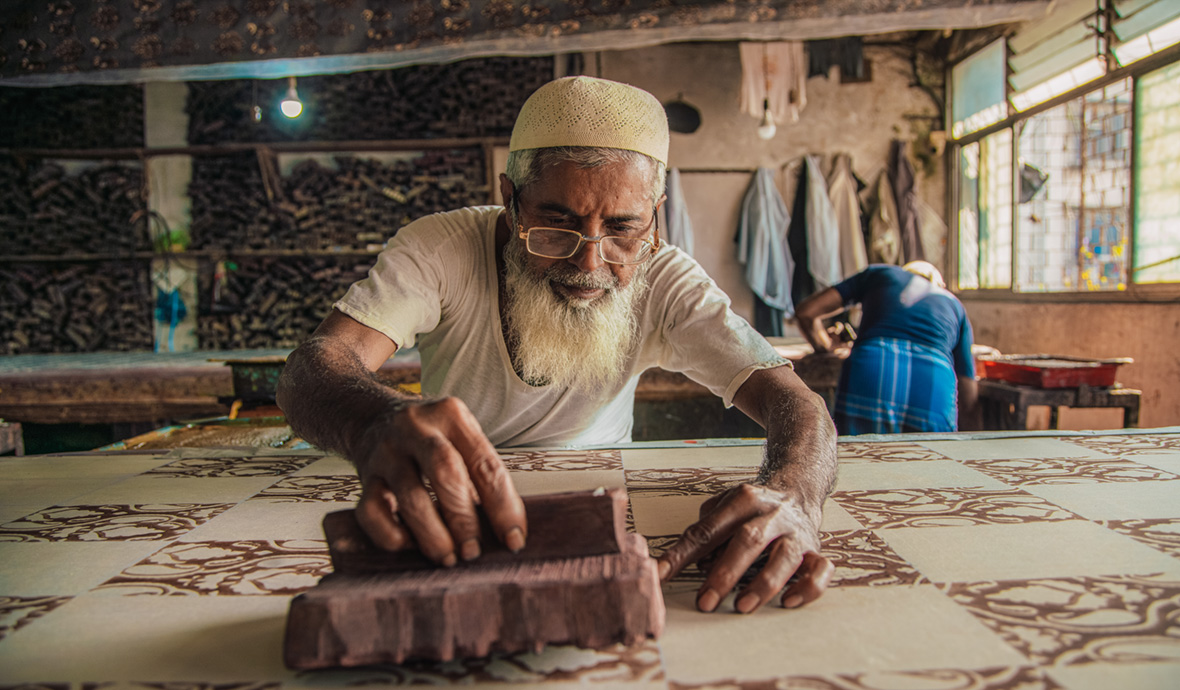
While some Ajrakh craftsmen still use natural dyes in rural parts of the country, ‘Pracheen’ is the only space to do so in the entirety of Mumbai. “Our processes and methods are derived from Ajrakh block printing. However our designs are original,” says Ahmed Khatri, the 64-year-old owner of Pracheen. As the fourth-generation in his family to block print, it was his great grandfather who migrated to Mumbai from the Kutch region in Western India and opened Pracheen almost 100 years ago. Pracheen, meaning ‘ancient’ in Hindi, has become a particularly fitting name for the shop.
Pracheen 是孟买市中心唯一一间坚持使用天然染料的作坊。64 岁的老板 Ahmed Khatri 说道:“我们沿用了传统的 Ajrakh 木刻印刷工艺,但图案设计由我们自己来做。”他是接管家族木刻印刷事业的第四代传人,100 年前,Ahmed 的曾祖父从印度西部的库奇地区移居孟买,一手创建了 Pracheen 工坊。“Pracheen” 在印地语中意为“古代”,对于这个祖传家作坊而言,这个名字显得尤其贴切。
Ahmed Khatri has fond memories of his childhood, which—when not in school—was spent learning the craft of blockprinting. “My father used to blockprint with chemical colors, but a client suggested we use natural dyes,” he says. “It was with his references that I connected with a man in Ahmedabad named Toofan Rafai, an expert in natural dyes in India. He was the man who taught me about the process of making natural dyes.”
Since then, Pracheen has only used natural dyes made in-house. Explaining the key difference between chemical and natural dyes, Khatri says, “Chemical colors produce loud shades whereas natural colors produce more earthy, soothing shades like that of henna or indigo as they are derived from various vegetables, roots, fruits, flower-saps, and herbs.”
Ahmed Khatri 对童年充满着愉快的回忆。不用上学的时候,他就跟着老师傅屁股后面学习木刻印刷工艺。他说:“我父亲以前曾用化学染料来做木刻印刷,但后来一位客户建议我们改用天然染料。在客户的引荐下,我认识了在艾哈迈达巴德的天然染料专家 Toofan Rafai,正是他教会了我如何制作天然染料。”
从那时起,Pracheen 就只使用自己制作的天然染料。Ahmed Khatri 随后解释了化学染料与天然染料之间的主要区别:“化学染料会产生较明显的阴影,而天然染料提炼于各种蔬菜、根茎、水果、花树汁和草本植物,能呈现出更加朴实、自然的色彩,例如海娜粉或靛蓝色。”
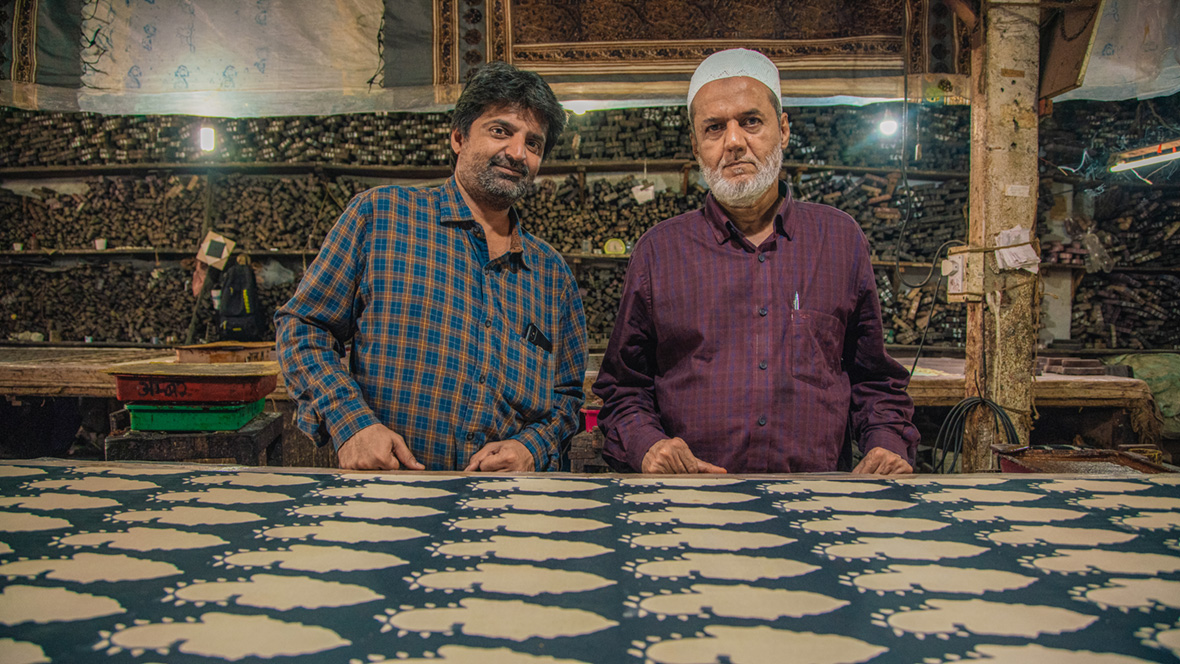
Having stuck with natural dyes for the past 30 years, Pracheen has earned a reputation with a niche set of clientele that includes international designer labels and boutique shops across the country. Ahmed Khatri runs the workshop and showroom with his son, Sarfraz Khatri, who has worked in Pracheen since he was a teenager. “One day I came to the unit and my father gave me tiny pieces of cloth and natural dyes to play around with,” he says. “I started mixing dyes randomly to create shades and got interested in natural dyes. My father has always taught me to keep innovating. This approach as well as using natural dyes means none of our designs and shades is the same—and that is the magic of Pracheen.” Now 40 year old, Khatri has played a major role in making Pracheen the brand that it is today. The 12 kaarigars, some of them having spent decades working at Pracheen, are equally instrumental to the shop’s success of course, and together, they’ve become a family of sorts.
从过去 30 年来,Pracheen 始终坚持使用天然染料,在小众市场中享有盛誉,获得了包括国际时装品牌和印度当地的时装店的认可。Ahmed Khatri 的儿子 Sarfraz Khatri 从少年起就和父亲一起经营 Pracheen。Sarfraz 说:“有一次父亲给了我一小块布和一些天然染料,让我自己捣鼓。自那开始,我便对天然染料产生了深厚兴趣。父亲一直鼓励我不断创新。在他的引导下,加上坚持使用天然染料,Pracheen 的设计和颜色调配在城里才绝无仅有,这也正是我们工坊的魅力所在。” 对于今天 Pracheen 品牌取得的成就,现年 40 岁的 Sarfraz 功不可没。作坊的成功也自然离不开在这里工作的其他十二名工匠,他们当中有的人甚至已经呆了数十年。Pracheen 就像个大家庭。
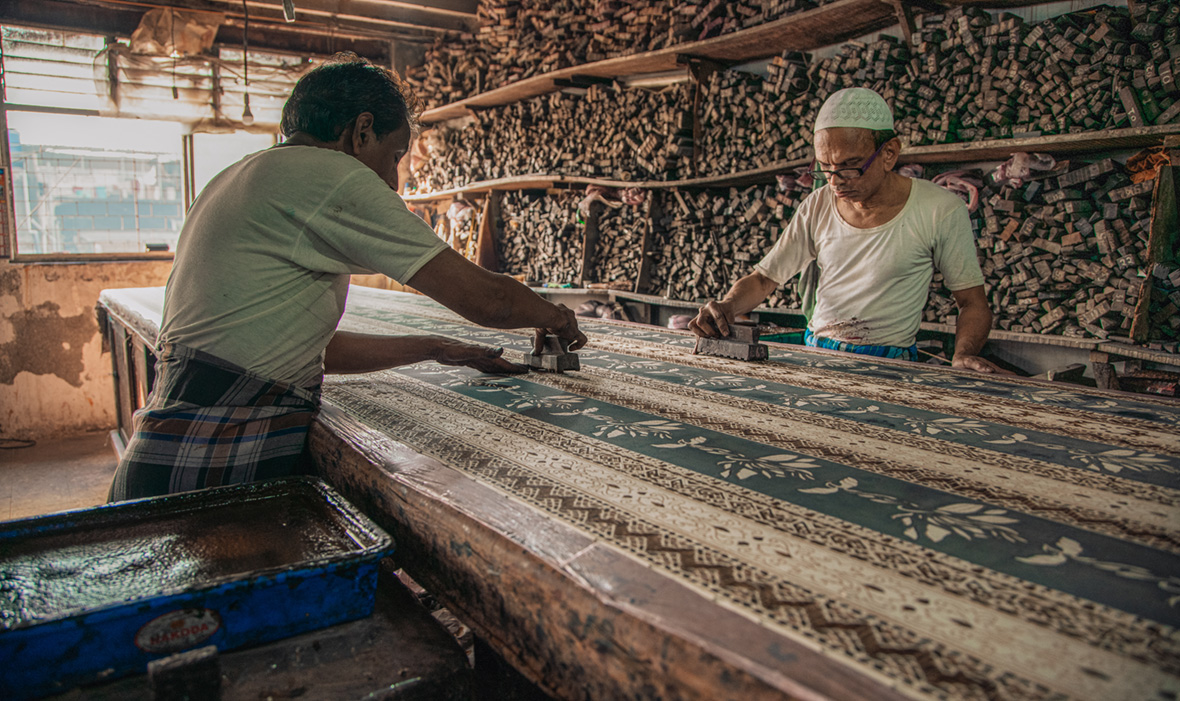
“Blockprinting using natural dyes is a tedious, labor-intensive process; one piece takes at least around two months to prepare,” says Sarfraz. “The color needs to be extracted from the roots and mixed with minerals. The fabric then needs to be dipped in the dye, washed thoroughly, and kept in the sun for eight to ten days. The blocks themselves also require intricate design work. The first block creates the background, followed by an outline and three to four inner fillings. It’s important for the shape of the blocks and the pressure applied to be even. If they’re uneven then one spot comes off darker than the rest. This consistency requires experience, craftsmanship, and a composed focus. This is why we never coerce our craftsmen to give us quantity, but quality.”
The craftsmen echo Sarfraz’s sentiments. Their oldest kaarigar, Jalaluddin, has worked at Pracheen for 50 years, starting when he was only 13. He says that each print requires effort, passion, and cannot be hurried. Another kaarigar, 62-year-old Salim Ahmed too holds Prachin very close to his heart. “I learned the craft here and have been working here all my life,” he says. “Our seth (boss) makes the colors and we print them. I cannot imagine doing anything else.”
Sarfraz 说:“使用天然染料进行木刻印刷是一个繁琐而费力的过程;一件作品往往需要至少大约两个月的时间制作。你需要先从植物根部萃取颜色,然后与矿物质进行混合。再将布浸入染料中,彻底清洗。通常需要在阳光下放置 8到 10天。而木块本身也需进过复杂的设计过程,先用大木块支撑背景,然后用细小的木块固定轮廓,再用到三到四个木块辅助图案的填充。更为重要的一点是,要保证木块形状的固定,木块和木块之间的彼此受力也要平衡,否则就会导致颜色深浅不一。如此复杂的工艺程序,需要丰富的经验、精湛的工艺和极致的匠人心。正因如此,我们从不催促工匠,保质不保量。”
关于这一点,作坊的工匠们也深以为然。他们当中年纪最大的 Jalaluddin 从13 岁就加入了 Pracheen,至今已经工作了五十年。他认为,每一件作品都需要投入大量的精力和热情,绝不能操之过急。而对于另一位 62 岁的工匠 Salim Ahmed来说,Pracheen 则有更多的含义。他说:“从学习工艺开始,我的一生都在这里。老板负责制作染料,我们负责印刷。实在无法想象如果转行去做其他地方工作是怎样一番场景。”
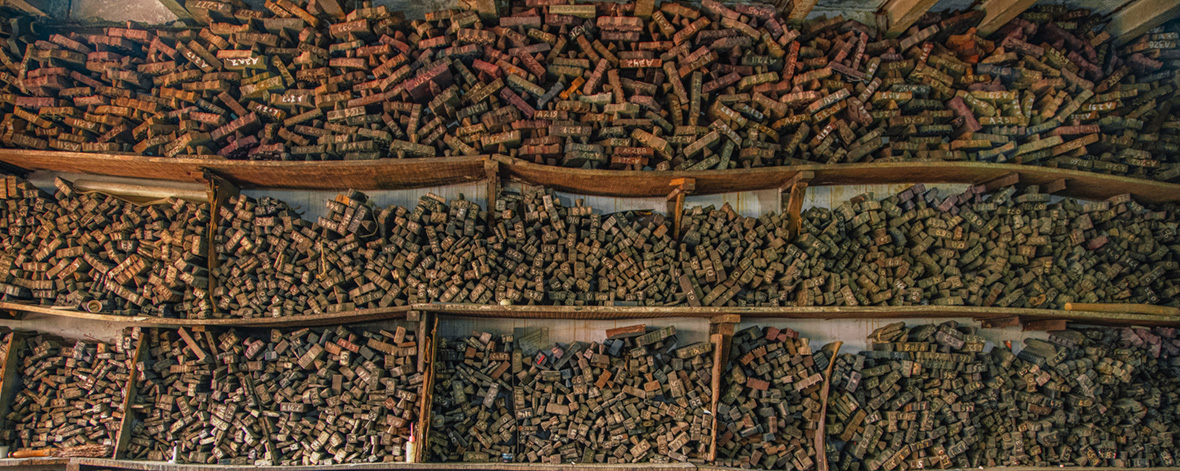
The workshop is abuzz with activity as the attentive craftsmen move around the space, preparing fabric, readying dyes, and grabbing blocks. The wall shelves are stacked with about a hundred thousand wooden blocks, some of which are almost a century old and have been revived through repair or a replica copy. “We also make new blocks to keep innovating our designs,” Sarfraz adds.
In a world of digital printing and cheap chemical dyes, it hasn’t been easy remaining insistent on block printing with natural dyes. The time, effort and passion put into this craft are often overlooked by the masses. The Khatris admit that it has been hard competing with mass production. However, awareness around sustainability and ethical fashion has increased in the last decade, which has been encouraging for Pracheen. With this movement, the owners have found renewed faith in their craft. “In 1997, I was invited for a Shibori Exhibition hosted by the National Institute of Design in Ahmedabad, Gujarat,” Ahmed Khatri recalls. “We had made 25-30 dupattas, stoles, and scarves. Within a few hours, by the grace of God, we were sold out. After that day my confidence just grew and I’ve never looked back.”
专心工作的工匠来来往往,准备布料、染料和取木块,整个作坊里热闹非凡。墙上的搁架堆放着近十万块雕刻木块,其中一些已经有近一个世纪的历史,又通过修整或复刻被重新利用。“因为我们对设计总有新的需求,所以木块的雕刻也在不断更新。”Ahmed 补充道。
在数字印刷和廉价化学染料成为主流的时代,坚持使用天然染料进行木刻印刷并非易事。大众常常忽略投入这种工艺所需的时间、精力和热情。Khatris 家族承认小作坊很难与大批量生产行业竞争。但值得庆幸的是,在过去十年中,人们对传统可持续发展的意识有所提高,越来越多人开始关注这种古老的风尚。这对 Pracheen 来说是令人鼓舞的事实。
Khatris 家族产业重拾对传统工艺的信心。Ahmed Khatri 回忆说:“1997 年,我受邀参加了由国家设计研究院主办,在古吉拉特邦艾哈迈达巴德举行的 Shibori 染色工艺展览。我们制作了 25 至 30 件 Dupattas(一种裹住全身的印度女性围巾服饰)、披肩和围巾,不到几个小时就被抢购一空。自那天之后,我们的信心倍增,再也没想过放弃。”(注:Shibori是一种历史悠久的染色技术。)
Being situated in Mumbai, the hub of Bollywood and Indian fashion; Pracheen’s approach and work ethic has also been recognized by local and international designers alike. One of them being renowned Indian designer Tarun Tahiliani, who, as Ahmed Khatri recounts, would spend entire days with them discussing fabric, design, and craft.
Other designers who have visited Pracheen include Donna Karen from DKNY, Yohji Yamamoto, and more. Pracheen’s craft collection in collaboration with designer Anjali Patel Mehta of Studio Verandah was also part of the Lakme Fashion Week’s Sustainable Fashion Day event Craft Is Cool, which introduced the traditional craftsmen to many more contemporary designers.
In a country that hasn’t had much public investment, incentive, or infrastructure for indigenous art forms to thrive, this was a particularly important event. These arts, , including block printing, are becoming more and more obsolete as younger generations seem unwilling to carry the torch. Blockprinting, unfortunately, also does not escape this fate. Kamaluddin’s son looks forward to getting a service-based job and Jalaluddin’s sons are not interested in getting into the field.
孟买是印度的宝莱坞和时尚中心,在这里,Pracheen 的理念和道德工艺获得了本地和国际设计师的青睐。其中之一是著名的印度设计师 Tarun Tahiliani。Ahmed Khatri 称这位设计师常常连续好几天和他们讨论织物、设计和工艺。
其他到访过 Pracheen 的设计师包括 DKNY 的 Donna Karen、山本耀司等等。Pracheen 与 Studio Verandah 的设计师 Anjali Patel Mehta 合作的工艺系列还参加了 Lakme 时装周可持续时尚日活动“Craft Is Cool”。这门传统工艺也吸引了越来越多的当代设计师。
在印度当地,没有太多公共投资、激励措施或基础设施来支持这项传统艺术的发展。因此,国际交流活动就显得尤其重要。由于缺乏年轻一代的传承者,许多传统艺术正消声匿迹,更不幸的是,木刻印刷也无法逃脱这一命运。Kamaluddin 的儿子想找一份服务行业工作,而 Jalaluddin 的儿子也对木刻印刷不感兴趣。

With the onset of the sustainable fashion movement, Sarfraz feels that traditional blockprinting still has huge potential and can make a comeback. “We need more encouragement and platforms for indigenous artists to exhibit their work so that they can claim their craft and agency,” he says.
In that hope, Pracheen continues stamping its legacy; hoping that the ‘ancient’ can become just as relevant in the future.
随着可持续时尚运动的展开,Sarfraz 认为传统木刻印刷仍有巨大的潜力,有卷土重来的机会。他说:“我们需要更多平台的支持,让传统艺术家们获得更多展示作品的机会,让他们能为自己手艺和能力申明。” 与此同时,Pracheen 将继续巩固和传承这一工艺,希望这种源于“古代”的工艺在未来依然能发扬光大。
Like our stories? Follow us on Facebook and Instagram.
Website: www.pracheen.com
Contributor: Devyani Nighoskar
Photographer: Rashi Arora

